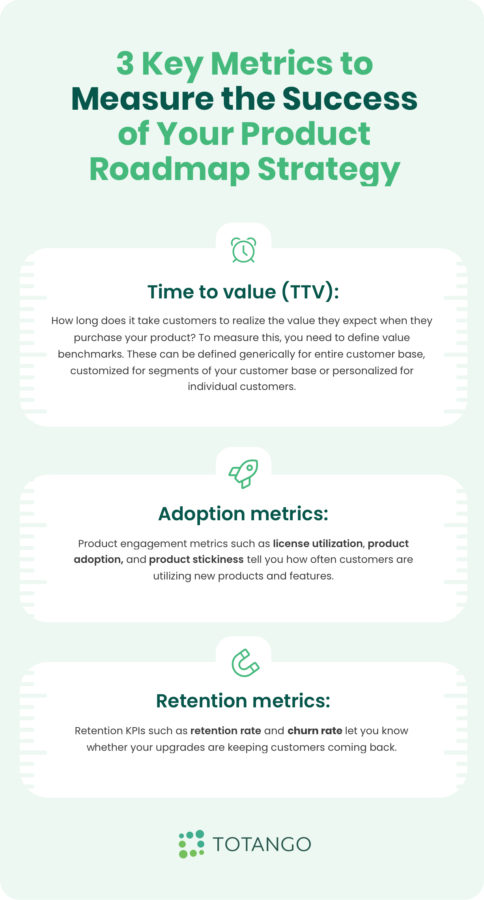Knowing how to build a customer-centric roadmap helps you align your product development with what your clients truly want. This promotes customer satisfaction, benefiting your clients and bringing your business higher retention rates and upsell revenue.
In this blog, we’ll look at the keys to building a customer-centric roadmap. First, we’ll consider why being customer-centric with your product development is so important in today’s digitized economy. Then, we’ll walk you through three steps to building a customer-centric roadmap. In the process, we’ll show you how technology can help you design a product roadmap geared toward your customers’ needs.
Why You Need to Know How to Build a Customer-Centric Roadmap
A customer-centric product roadmap meets the needs of today’s digital-driven SaaS market. Today’s SaaS customer makes purchasing decisions based on their digital experience of your brand. This means that successful brands need to align their product experience with what data indicates about customer needs. Failing to do this results in a disconnect between your product features and your customer, reducing the value customers derive from your product and prompting them to take their business to more responsive providers.
The customer centric approach to product roadmaps seeks to address this issue by systematically incorporating customer data into product development. It uses data from sources such as support tickets and satisfaction scores to identify features that will meet customer needs. It further incorporates data after new features have been implemented to verify that customers are getting the desired results. This strategy helps ensure that new product features are delivering the benefits customers want through experiences aligned with customer success goals.
How to Build a Customer-Centric Roadmap: Three Steps
The process of building a customer-centric roadmap can be broken down into three major steps:
- Examine your current roadmap
- Use your data to plan new features
- Measure the success of your upgrades
Let’s look at what each step involves.
1. Examine Your Current Roadmap
Customer data forms the foundation of a customer-centric roadmap strategy. Use the data from your customer success platform to review and reorient your current roadmap.
One key source of data is support tickets. Your customer escalations indicate which issues customers are currently encountering. This can suggest the issues new features need to address.
Another important source of data is customer satisfaction surveys. Feedback from CSAT surveys and other customer satisfaction surveys lets you listen to what your customers want and need to drive their business outcomes.
2. Use Your Data to Plan New Features
Monitoring your customer data helps you understand what your customers need. For example, if you notice a particular support issue is coming up frequently, a new feature that solves this problem would be desirable for your customer base with the added benefit of reducing Support resources. Similarly, if customers keep voicing the same complaint or request in their feedback, this provides valuable information on where to go with your roadmap.
Another factor to consider when developing new features and products is feature stickiness. What does your customer product usage data show about which features customers use most frequently when they log in? What does this suggest about what to include in product upgrades?
When upgrading your product, marketing considerations also come into play. To make your product stand out from the competition, you need unique features to showcase. Consider how you can develop new features that deliver solutions in ways your competitors aren’t already doing.
3. Measure the Success of Your Upgrades
Customer data can also help you measure the success of your product roadmap strategy. Several key metrics can help you evaluate the performance of your upgrade efforts. These include:
- Time-to-value (TTV): How long does it take customers to realize the value they expect when they purchase your product? To measure this, you need to define value benchmarks. These can be defined generically for the entire customer base, customized for segments of your customer base or personalized for individual customers.
- Adoption metrics: Product engagement metrics such as license utilization, product adoption and product stickiness tell you how often customers are utilizing new products and features.
- Retention metrics: Retention KPIs such as retention rate and churn rate let you know whether your upgrades are keeping customers coming back.
Monitor these types of metrics to evaluate the success of your product roadmap strategy and make appropriate adjustments as needed. In this way, you can continually improve your roadmap to make it, even more, customer-centric.
Build a Customer-Centric Roadmap to Promote Client Satisfaction
A customer-centric approach to product roadmaps lets you leverage customer data to bring features and products into alignment with what your data indicates about customer needs. This promotes higher customer satisfaction, leading to more retention and upsell revenue for your business.
You can implement a customer-centric product roadmap strategy by using data from your customer success platform, such as support tickets and satisfaction surveys, to gather intelligence about customer needs. This enables you to develop sticky features that will meet customer needs, promote product usage and make your brand stand out. Using KPIs to track the reception of new features helps ensure that your upgrades are delivering the results customers want.
Totango’s customer success platform includes tools to help you implement a customer-centric roadmap, including the ability to monitor escalations, satisfaction scores, and KPIs critical for measuring the success of your strategy. Try it free to experience how cutting-edge customer success technology can provide you with the data you need for customer centric product development.


